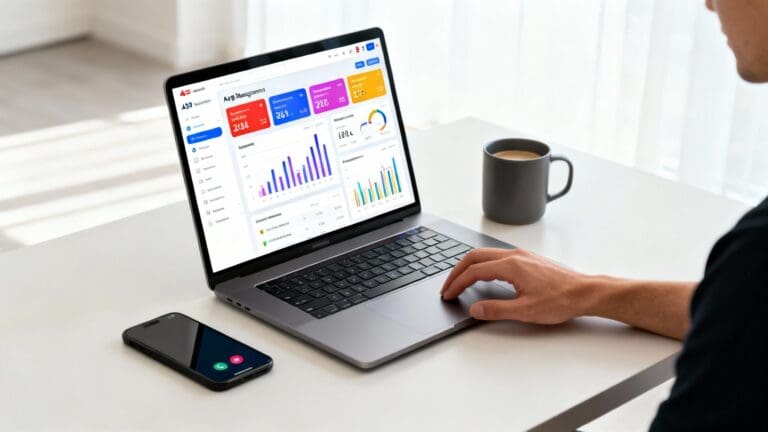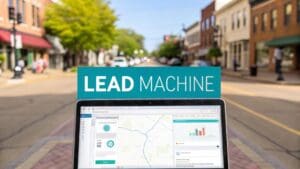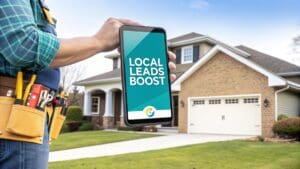Ever feel like running ads is some secret club you weren’t invited to? Like it’s for tech wizards and marketing gurus only? Let’s bust that myth right now.
You can absolutely run ads for your own business. It’s way, way simpler than you think. You don’t need a secret password or a fancy degree. All you need is a plan, and the biggest step is just deciding to start. You can do this, and we’re here to help.
Why You Should Run Your Own Ads
Think of it like learning to cook a new dish. The recipe might look strange at first, but once you have the ingredients and a simple guide, you can make something amazing. Running your own ads gives you a superpower: you get to decide who sees your business and how you find your next customer.
Take Control of Your Growth
When you learn how to run your own ads, you take back the power. No more relying on expensive agencies or confusing middlemen. You get to talk directly to the people who need what you offer.
This has some awesome perks:
- You save a ton of money: Forget paying big fees to someone else. Every dollar you spend goes straight to finding new customers.
- You move way faster: Got an idea for a weekend sale? You can create an ad in minutes, not days. No more waiting around.
- You know your customer best: Nobody understands your people better than you do. You can write ads that sound like a real person talking, making a real connection.
The Opportunity Is Huge
Almost everyone is online now, and that’s where businesses are finding new customers. In fact, most of the money spent on advertising is now spent on online ads.
That tells you something important: running online ads isn’t just a fun idea. It’s the main way businesses get new leads.
You don’t need a giant budget or a fancy marketing degree. What you need is to be willing to learn and have the confidence to press “go.”
By the end of this guide, you’ll see that you’ve totally got this. We even have a program called Super Simple Ads made to get you started with zero stress.
Let’s do this!
Choosing Your Ad Playground: Facebook vs. Google
So you’re ready to run some ads, but where do you start? The two biggest players are Facebook (which includes Instagram) and Google. Let’s figure out which one is best for you.
Think of it this way: Google is like putting up a billboard for people who are already driving to the store to buy what you sell. They know they have a problem right now and are actively looking for a solution.
Facebook and Instagram are more like a fun neighborhood party. You get to introduce yourself to people who would love what you do, but they don’t even know you exist yet. You’re showing up where they’re already hanging out and having a good time.
When Google Makes the Most Sense
Picture this: a pipe just burst in someone’s basement. They aren’t scrolling through photos of their friend’s cat. They’re grabbing their phone and typing “plumber near me” as fast as they can.
That’s a Google moment.
The customer has an urgent problem, and you have the answer. Google is perfect when your business solves a specific problem that people search for. They’re literally typing their needs into a search bar. Your job is just to show up as the best answer.
This picture helps explain it.
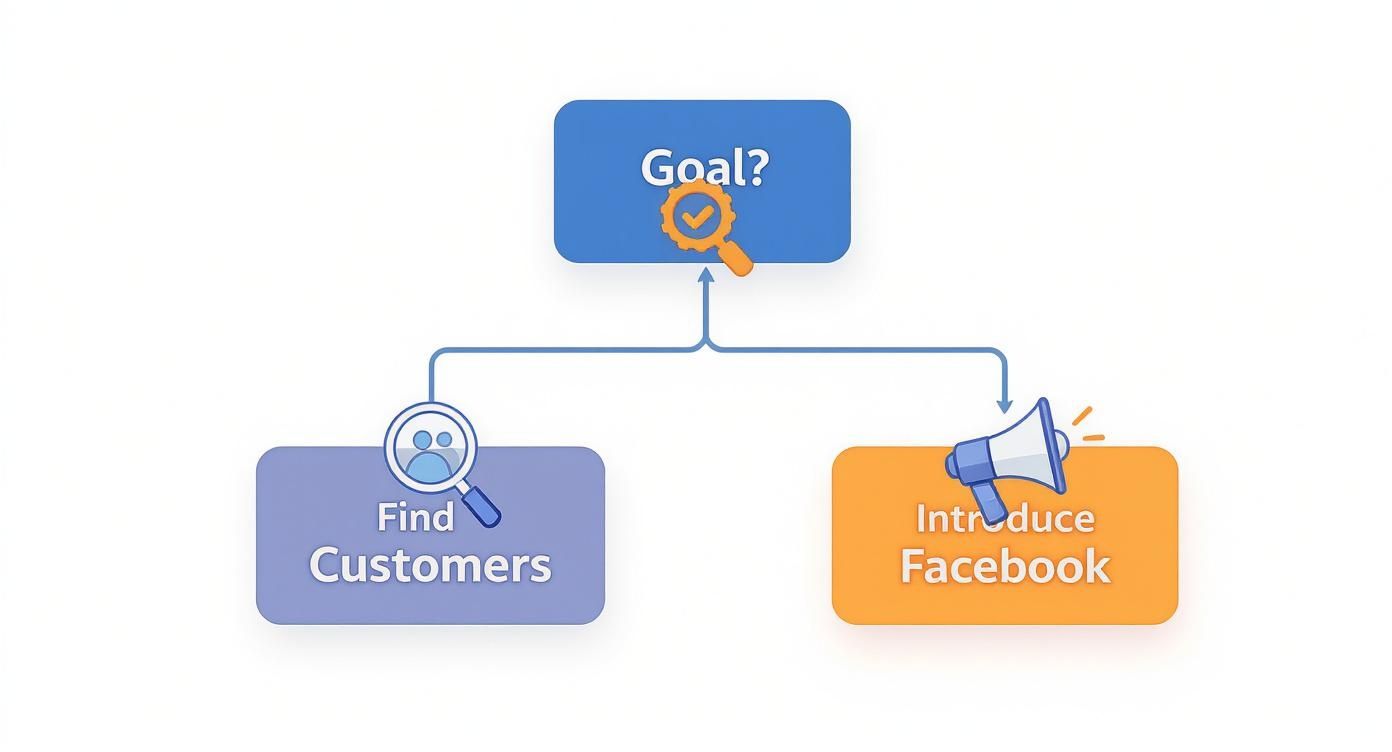
As you can see, if you want to get in front of customers who are already looking for you, Google is the fastest way to get your phone to ring.
When Facebook and Instagram Shine
Now, imagine you sell really cool, handmade coffee mugs. It’s pretty rare that someone wakes up and urgently searches for a “blue speckled artisan coffee mug.” That’s not really a thing.
Instead, your ideal customers are probably scrolling through Instagram, looking at pretty pictures of homes and coffee. This is where Facebook and Instagram ads work their magic. You can pop your awesome mugs right into the feeds of people who like local coffee shops or follow home decor accounts.
You aren’t waiting for them to find you; you’re going out and finding them.
The real power here is that you’re making someone stop their scroll and think, “Whoa, I need that!”
This is the perfect way to go for businesses where buying is more about seeing something cool. Think restaurants showing off a new dessert, clothing stores with a new jacket, or real estate agents showing off a beautiful house. It’s also great for local businesses building a community following.
Facebook vs Google Ads: Where to Start
Still not sure? This simple table breaks it down to help you decide which is the best starting spot for your business.
| Factor | Facebook & Instagram Ads | Google Ads |
|---|---|---|
| Customer Mindset | Just browsing (“Discovery”) | Looking to buy now (“Intent”) |
| Best For | Showing off cool stuff, building a brand | Getting leads for a service people need now |
| Typical Business | E-commerce, restaurants, boutiques, artists | Plumbers, lawyers, roofers, dentists |
| Main Goal | Getting people to know and like you | Getting phone calls and form fill-outs |
| Ad Format | Pictures and videos are everything | Mostly just text |
Both are great tools, and most businesses end up using both. But when you’re just starting, it’s best to pick one and get good at it.
Making the Right Choice for Your Business
Don’t make this complicated. Just answer one simple question:
“Are my customers looking for me, or do I need to go find them?”
- Choose Google if: People search for what you do when they have a problem. You’re a roofer, a dentist, a lawyer, or an HVAC company. You want to get leads right away from people ready to buy.
- Choose Facebook/Instagram if: Your product is something people buy because it looks cool, not because it’s an emergency. You’re a coffee shop, a real estate agent, or an online store.
The key is to pick one, get that first win, and build your confidence. For those diving into Facebook, mastering Facebook Ad campaigns is key to turning your ad money into actual customers.
You can do this. Start simple, pick your playground, and let’s get you in front of people who need you.
Creating Ads That People Actually Enjoy
Okay, this is the fun part. Let’s forget the technical stuff for a minute. Making the ad is where your business’s personality gets to shine.
A great ad isn’t a pushy sales pitch. Think of it as a friendly “Hello!” to people who could be your next best customers. It’s the start of a conversation, not an argument.
You don’t need to be a creative genius for this. You just need three key pieces. We’re going to walk through each one, and you’ll see just how simple it is.
Seriously, you can do this.

The Scroll-Stopping Picture or Video
Think about how you use social media. You’re scrolling, scrolling, scrolling… then something catches your eye and you stop. That’s what your ad’s image or video needs to do. Its only job is to make someone pause for a second.
This is where people get stuck. You don’t need a Hollywood film crew. In fact, super slick and polished photos often do worse because they scream “I’M AN AD!” and people just ignore them.
Here’s what works instead:
- Real People, Real Smiles: Photos of you, your team, or a happy customer always win. If you’re a roofer, show your friendly team in front of a finished house. If you sell coffee, show someone loving their drink.
- Bright and Clear: Make sure your photo is easy to see and not blurry. A dark, fuzzy photo will get ignored every time. Your phone’s camera is probably perfect for this!
- Keep it Simple: Your picture should have one main thing to look at. Don’t try to show too much at once. One great image is better than a busy, confusing one.
Pro Tip: If you run a service business, a short video of you explaining a common problem or giving a quick tip works like magic. It builds trust because people can see the real person they’d be working with.
Words That Make People Curious
Once your picture has stopped the scroll, your words have to get them interested. This isn’t the time for big, fancy business words. Just talk like a normal person. Write like you’re explaining your business to a friend.
The goal is to connect with a problem your customer has. The easiest way to do this is with a simple headline formula that’s impossible to mess up.
Tired of [The Problem]? Try [Your Solution]!
Let’s see it in action:
- For a lawn care company: “Tired of mowing your lawn all weekend? Get your Saturday back with our easy lawn service!”
- For a local restaurant: “Tired of the same old takeout? Try our new wood-fired pizzas tonight!”
See how simple that is? You pointed out a problem and immediately offered the answer. The rest of your ad text should be just as simple. A sentence or two explaining how you solve their problem is all you need.
The Clear Next Step
This is the most important part, and it’s where so many people mess up when they first learn how to run your own ads. You’ve got their attention, you’ve made them curious… now what?
You have to tell them exactly what to do next.
This is your call to action. It needs to be super clear and direct. Don’t be shy. Don’t make them guess.
Here are some great examples:
- “Click ‘Learn More’ to see our menu.”
- “Tap ‘Book Now’ to get your free estimate.”
- “Visit our website to get 10% off.”
- “Call us today for a free quote.”
Notice how they all start with an action word (Click, Tap, Visit, Call). The button on your ad should match the action. If you want people to call you, the button better say “Call Now.” It’s that simple.
You’re just helping them take the next step from being a curious stranger to a happy customer. You can learn more about how local businesses can turn on ads that bring in customers by keeping things this simple.
Designing a Website That Welcomes New Customers
So, you’ve got a great ad running. It’s getting attention, people are clicking, and you’re feeling awesome. High five!
But… where are they going after they click? This is the moment where things can fall apart, but we’re not going to let that happen to you.
Your ad is like a friendly wave from across the street. Your website is your front door. Sending all those people to a confusing or slow website is like inviting guests to a party and then locking the door. Ouch. It wastes every penny you spent on the ad.
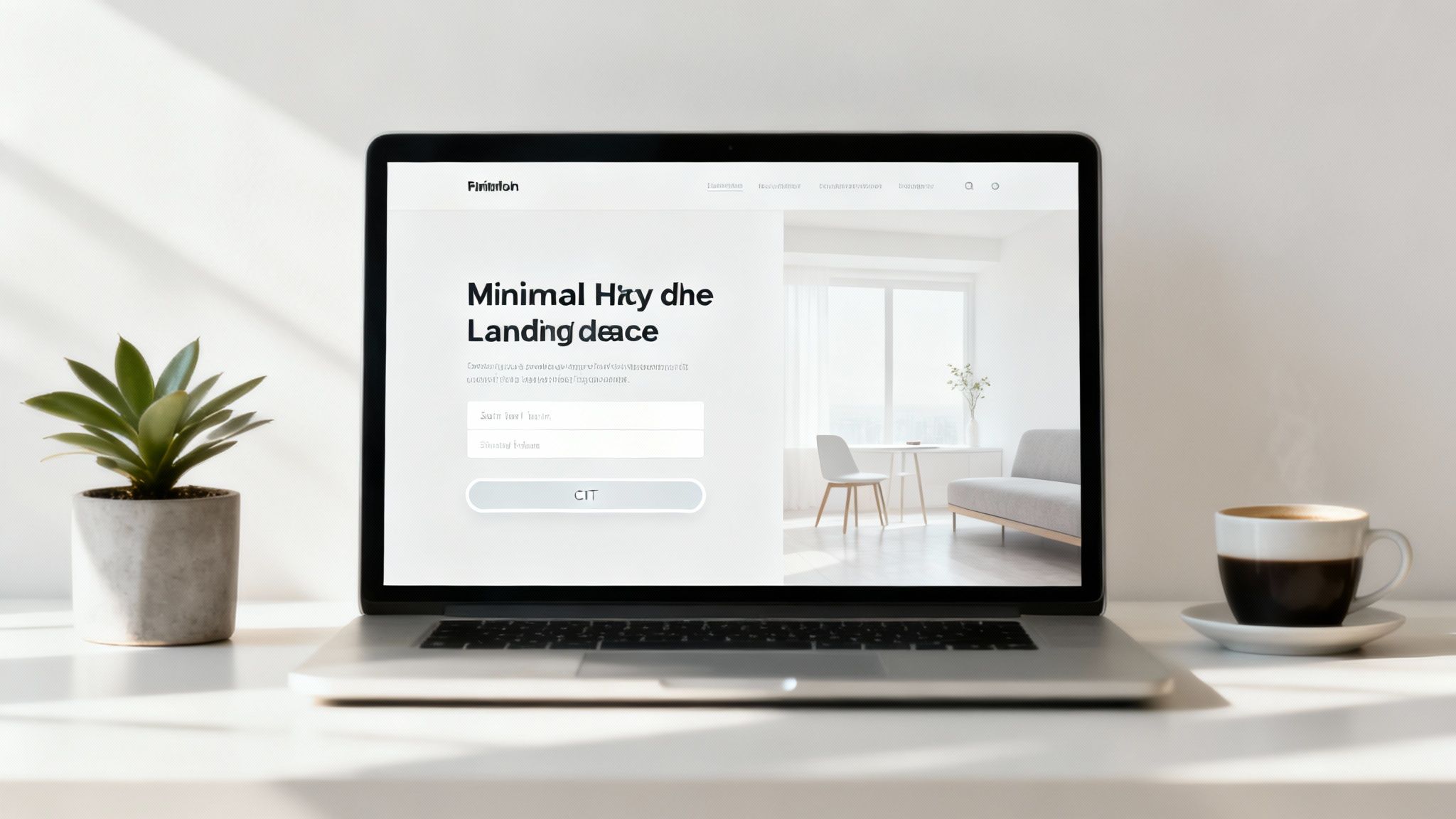
This part is the secret to lead generation. We’re talking about your “landing page”—which is just a fancy name for the page your ad sends people to. Its only job is to get that person to take one specific action.
Your Website Has One Job
When someone clicks your ad, they’re on a mission. You promised them something—a discount, more info, an answer to their problem—and your page has to deliver on that promise right away.
Don’t send them to your homepage to get lost. Send them directly to a page that continues the conversation you started in the ad. That page should be focused on one single goal.
Here are the most common goals:
- Get a Lead: Get them to fill out a short form.
- Make a Sale: Send them to a product page to buy.
- Schedule a Call: Make it super easy to book a time to talk.
That’s it. Don’t try to do everything at once. Pick one goal and build the page to do only that.
Keep the Conversation Going
The most important rule for a good landing page is matching. The look and words must perfectly match the ad they just clicked.
If your ad shows a picture of you smiling and promises a “Free Quote,” your landing page better have a picture of you smiling and shout “Get Your Free Quote!” right at the top.
If there’s a disconnect, it feels weird and untrustworthy. People will hit the “back” button faster than you can say “lost lead.”
A great landing page feels like the next logical step. It reassures the visitor they’re in the right place and that you’re about to deliver on your promise.
This simple act of matching builds the trust you need to turn a click into a customer. It’s a key part of good lead generation website design for home services contractors, and it works for every type of business.
The Parts of a Perfect Landing Page
You don’t need to be a web design pro to do this. You just need a few simple parts.
1. A Headline That Matches Your Ad
This is the first thing they’ll read. It needs to be big, bold, and almost the same as your ad’s headline.
- Ad Headline: “Tired of a Messy Garage? Get Organized Today!”
- Landing Page Headline: “Finally Get Your Garage Organized with Our Simple Solutions”
See? It flows perfectly.
2. A Simple Form
If you want leads, your form is the star of the show. The key is to only ask for what you really need. Every extra question you ask makes it less likely people will fill it out.
For most businesses, this is all you need:
- Name
- Phone Number
Don’t ask for their whole life story. Just get enough info to start a real conversation.
3. A Big, Obvious Button
Your button should be impossible to miss. Use a bright color that stands out from the rest of the page—like bright orange or green.
The words on the button matter, too. Ditch the boring “Submit” and use something exciting that matches the offer.
- “Get My Free Quote!”
- “Schedule My Call”
- “Claim My 20% Discount!”
This isn’t rocket science; it’s just about being clear. When you learn how to run your own ads, this simple connection between your ad and your website is what makes you money. We’re here to help make sure your website is ready to turn those clicks into customers. You can do this.
Launching Your Ad and Tracking What Matters
Alright, it’s go-time! You’ve picked where to run your ad, your ad looks great, and your website is ready to welcome visitors. Hitting that “publish” button can feel like a big deal, but it’s the moment you’ve been working toward.
Let’s do this. First, we’ll set a budget that you’re comfortable with—yes, you can start with just $5 a day. Then, we’ll look at the only numbers that really matter. Forget the confusing charts and weird terms. We’re keeping this simple.
Setting a Budget That Makes Sense
“How much should I spend?” This is the question everyone asks. The answer is simple: start with an amount you won’t lose sleep over.
Advertising is like planting a garden. You start small, water it, see what grows, and then you plant more of what’s working. A small daily budget of $5 or $10 is the perfect way to learn without taking a big risk.
Starting small is a smart move. Here’s why:
- It’s low-risk: You get to learn how things work without worrying about money.
- You get real answers: Even a few dollars a day will show you which pictures and words people like.
- It builds your confidence: Seeing those first few clicks come in for just a couple of bucks is an amazing feeling. It proves that this stuff actually works!
You are in total control. You can pause or stop your ads at any time. Think of your first week’s budget as a small investment in your own learning.
Focusing on the Numbers That Actually Matter
Once your ads are running, you’ll see a dashboard full of charts and numbers. It can look really confusing.
Good news: you can ignore almost all of it. To get leads, you only need to care about two things.
That’s it. Just two.
1. Clicks: How Many People Were Interested?
A “click” is exactly what it sounds like. Someone saw your ad and was curious enough to tap on it. Clicks are the first sign that your ad is working.
If you’re getting clicks, that’s a huge win! It means your picture was good and your headline worked. You passed the first test.
2. Leads (or Conversions): How Many People Took Action?
A “lead” is the golden ticket. This is the whole reason you’re running the ad. It’s when someone who clicked your ad actually does the thing you wanted them to do on your website.
This could be:
- Filling out your contact form
- Calling your business
- Scheduling an appointment
A lead means the whole thing worked. The ad got their attention, and your website convinced them to reach out. This is how you turn ad money into actual customers.
Think of it like a baseball game. Clicks are like getting a hit and getting on base. Leads are like a home run that brings a player home to score. You need both, but the home run is what wins the game.
Knowing if Your Ad Is Working
So, how do you know if you’re winning? Both Google and Facebook show you these two key numbers right at the top. Once your ads are live, understanding the key online advertising performance metrics is what helps you turn your campaigns into a profit machine.
Don’t panic if your numbers aren’t amazing on day one. Nobody’s are. The goal isn’t to be perfect right away; it’s to make progress.
If you’re getting clicks but no leads, that’s really helpful information! It tells you the ad is working, but your website might need a small change. Maybe your contact form is too long, or your “Get a Quote” button is hard to find. These are easy fixes.
This whole game is about making small changes over time. You’ll learn what works, and your results will get better and better. This isn’t a test you can fail; it’s a game you learn how to win. You’ve got this.
Common Questions About Running Your Own Ads
Still have a few questions? Good. That’s normal. When you first learn how to run your own ads, it’s smart to ask “but what if…?”
We’ve heard them all. Here are the most common questions we get, with simple, no-fluff answers to give you that final boost of confidence.
How Much Money Do I Really Need to Start?
This is the big one, isn’t it? The good news is you don’t need a boatload of cash. You can get started with a budget of just $5 a day. Seriously. That’s less than a fancy coffee.
For the price of a latte, you can put your business in front of hundreds of new people. The goal at the start isn’t to spend a lot; it’s to learn what works. Starting small lets you test things out with zero scary financial risk.
You are always in control. You can pause or stop your ads whenever you want.
What if My Ads Don’t Work?
First, don’t panic! It’s not a disaster. It’s just part of learning. Even the pros have ads that don’t work right away. The secret? They don’t see it as “failure.” They see it as helpful information.
If an ad isn’t getting you calls or leads, it’s just a clue.
- Lots of clicks but no leads? Your ad is great, but your website page probably needs a small tweak.
- Not many clicks? Time to try a different picture or a new headline. Easy peasy.
This isn’t about getting it perfect on day one. It’s about making small changes. Every ad you run teaches you something new about your customers. You learn something no matter what, so you can’t lose.
Do I Need to Be a Tech Whiz?
Absolutely not. If you can post on Facebook or send an email, you have all the tech skills you need. Both Google and Facebook have made their ad tools much simpler because they want small business owners like you to succeed.
It’s mostly just clicking buttons and filling in boxes. It’s designed to be simple.
Don’t let the fear of technology stop you. The platforms are built to walk you through it, step-by-step. We promise, it’s easier than putting together IKEA furniture. And way less frustrating.
How Long Does It Take to See Results?
You can see things happening a lot faster than you’d think. You’ll start seeing data like clicks and views within the first 24 hours. Getting actual leads can happen within the first week if your offer and your website are ready.
The key is to be patient with yourself. Your first ad is all about learning. It’s the second and third ads where you’ll really start to see things take off. For a deeper look, our guide to digital marketing for beginners is a great next step.
Getting good at ads is a journey, not a race. But the best part is, you get to see progress along the way. You can do this. You’re ready to start right now.
Ready to stop wondering and start growing? At The Cherubini Company, we help businesses get more leads without the headache. Our Super Simple Ads program and hands-on website design are built to make your phone ring. You’ve got this, and we’ve got your back. Learn how we can help your business today.

